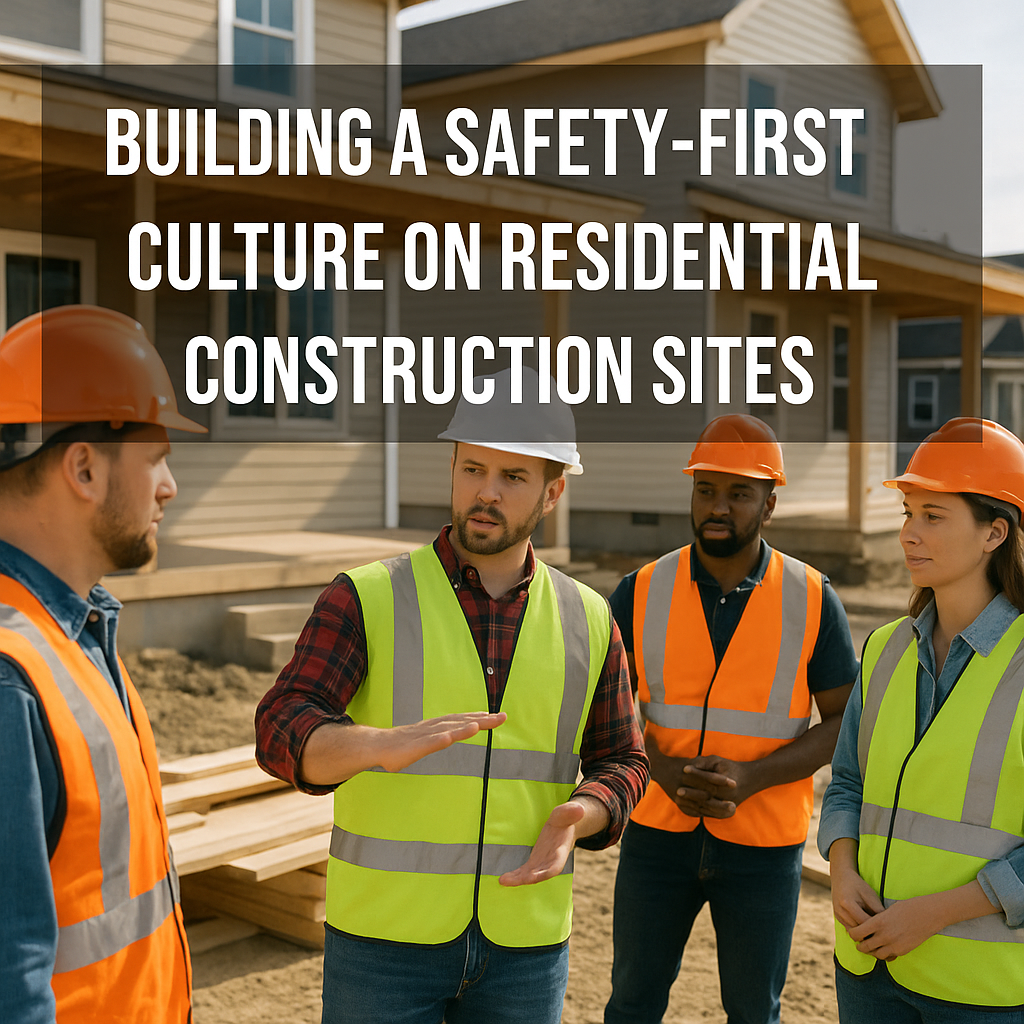Building a safety-first culture on residential construction sites is one of the most impactful ways to protect your workers, your business, and your reputation. The residential construction industry is filled with high-risk activities: working at heights, manual handling, power tool use, and more.

According to the U.S. Occupational Safety and Health Administration (OSHA) (dofollow), falls account for the largest number of fatalities in residential building. Even smaller contractors face strict regulatory requirements and the human cost of injuries can devastate both workers and companies.
Creating a safety-first culture isn’t just about following the rules—it’s about changing attitudes and behaviors at every level so that safety is genuinely valued and prioritized every day.
Understanding a Safety-First Culture
Before we dive into building a safety-first culture on residential construction sites, let’s define what it actually means.
A safety-first culture is one where:
- Safety is integrated into all work processes.
- Employees feel responsible for not just their own safety, but also their coworkers’.
- Supervisors and managers lead by example.
- Safety is discussed openly and regularly.
- Workers are encouraged to stop work if they identify a hazard.
In short, it’s a culture where safety isn’t an afterthought—it’s the way things are done.
Key Elements of Building a Safety-First Culture on Residential Construction Sites
Let’s look at practical strategies for building a safety-first culture on residential construction sites.
1. Leadership Commitment
It starts at the top. Company owners, site managers, and supervisors must model safe behaviors and make safety expectations clear.
Leaders should:
- Regularly visit job sites and engage with workers about safety.
- Allocate budget for PPE, training, and proper tools.
- Communicate that production never overrides safety.
- Include safety as a standing agenda item in all meetings.
Your team will take safety seriously only if leadership does too.
2. Employee Involvement and Empowerment
A safety-first culture thrives when workers feel heard and involved. Engage your crew by:
- Encouraging them to identify hazards and suggest solutions.
- Appointing safety champions on site.
- Setting up toolbox talks where everyone can share experiences.
- Making it easy to report concerns without fear of retaliation.
OHSE.ca (internal link) offers more resources on employee engagement strategies in construction safety.
3. Comprehensive Training and Education
Preventing accidents starts with knowledge. Every worker, from apprentices to veterans, benefits from clear and ongoing training.
Essential training topics include:
- Fall prevention and ladder safety.
- Proper use of scaffolding.
- Safe lifting techniques.
- Power tool and equipment safety.
- Hazardous material handling.
- Emergency response and first aid.
Training should be hands-on, practical, and tailored to residential construction tasks.
4. Consistent Communication
Safety must be part of the daily conversation on residential construction sites. Strategies include:
- Daily safety huddles to discuss site-specific hazards.
- Weekly toolbox talks on rotating topics (e.g., fall protection, PPE use).
- Posting clear safety signage and reminders around the site.
- Using text alerts or apps for weather warnings and urgent updates.
Good communication ensures everyone knows the expectations and risks each day.
5. Risk Assessments and Site Inspections
Building a safety-first culture on residential construction sites means proactively identifying and controlling hazards.
Key steps:
- Perform a Job Safety Analysis (JSA) before starting new tasks.
- Conduct daily site walkthroughs to spot changing conditions.
- Document near misses to learn from them.
- Address hazards immediately, not “later.”
Tools and templates for conducting risk assessments can be found at the Canadian Centre for Occupational Health and Safety (CCOHS).
6. Provide and Enforce PPE Use
PPE is your last line of defense but a crucial one. Build a safety-first culture by making PPE use non-negotiable.
- Provide quality hard hats, safety glasses, gloves, hearing protection, and fall arrest gear.
- Ensure workers know how to use and maintain PPE.
- Enforce use consistently—no exceptions for “just this once.”
- Replace damaged or worn-out gear immediately.
For practical guidance, see Essential PPE for Different Job Roles (internal link).
7. Encourage Reporting Without Blame
A blame-free reporting system is essential for identifying hidden hazards.
- Make it clear that all incidents, including near misses, must be reported.
- Reward reporting as a positive behavior.
- Use reports to fix root causes rather than punish.
- Share lessons learned with the entire team.
This approach fosters trust and learning, not fear.
8. Recognize and Reward Safe Behavior
Positive reinforcement can transform safety from a chore to a source of pride.
- Publicly acknowledge crews or individuals who demonstrate excellent safety practices.
- Offer small incentives for reporting hazards or suggesting improvements.
- Celebrate milestones like accident-free days or months.
Recognition shows that safe work matters just as much as quality and productivity.
Benefits of Building a Safety-First Culture on Residential Construction Sites
Why go to all this effort? Because the benefits are clear and impactful:
- Fewer injuries and fatalities on site.
- Lower insurance premiums and compensation costs.
- Improved productivity—fewer delays from accidents or investigations.
- Stronger reputation with clients and the community.
- Happier, more loyal workforce who feel valued and protected.
Safety isn’t a cost—it’s an investment in your business’s success.
Final Thoughts on Building a Safety-First Culture on Residential Construction Sites
Building a safety-first culture on residential construction sites is not just a box to check—it’s an ongoing commitment that pays off in every way.

When safety becomes part of the company’s DNA, workers look out for each other, supervisors lead by example, and risks are addressed before injuries happen.
By prioritizing training, communication, risk assessment, PPE, and positive reinforcement, you can transform your construction site into a safer, more productive, and more professional environment.


No comments yet